✨Intense Pulsed Light (IPL): Restore Radiance and Reverse Sun Damage
What is IPL?
Intense Pulsed Light (IPL), also known as a “photofacial,” is a non-invasive light-based treatment that targets discoloration, sun damage, and uneven skin tone. It helps brighten, smooth, and rejuvenate the skin with little to no downtime — making it a favorite for achieving a more even, youthful complexion.
IPL vs. Laser: What’s the Difference?
While both IPL and laser treatments use light energy to improve skin texture and tone, IPL delivers multiple wavelengths of light, allowing it to address several skin concerns at once.
-
Laser treatments are single-wavelength and more targeted — stronger but with longer recovery.
-
IPL is gentler, with shorter downtime but may require a series of sessions for best results.
What Skin Concerns Can IPL Treat?
IPL is one of the most versatile skin rejuvenation treatments. It effectively treats:
-
Sun spots and age spots
-
Dark spots caused by hormones or post-inflammatory pigmentation
-
Redness and broken capillaries
-
Spider veins
-
Stretch marks and uneven texture
Because these concerns can appear anywhere, IPL is commonly used on the face, neck, chest, arms, hands, and back.
Who is the Best Candidate for IPL?
IPL works best on fair to medium skin tones. It is not ideal for darker skin types due to the higher risk of pigmentation changes or uneven light absorption. A personalized consultation ensures IPL is right for your skin type and goals.
What to Expect: Session Time & Frequency
Treatment time depends on the area — a full-face IPL typically takes 20–30 minutes.
Most patients see best results with a series of 3–5 treatments, spaced 4–6 weeks apart, followed by maintenance every 6–12 months to keep skin clear and luminous.
When Will I See Results?
Right after IPL, you may experience mild redness or warmth — like a light sunburn — for 1–2 days.
Within 1–3 weeks, dark spots may temporarily darken before naturally flaking off, revealing brighter, smoother, more even-toned skin underneath.
Are IPL Results Permanent?
While IPL can dramatically improve pigmentation and skin tone, it can’t stop the natural aging process. Sun protection is key — daily sunscreen and good skincare habits help maintain your results long-term.
Why Patients Love IPL
✔ Non-invasive and gentle
✔ Treats multiple concerns at once
✔ Minimal downtime
✔ Noticeable improvement in tone and texture
Ready to reveal brighter, clearer skin?
Book your IPL photofacial consultation today and see how light can bring back your natural glow.
💡High-Intensity Focused Ultrasound (HIFU)
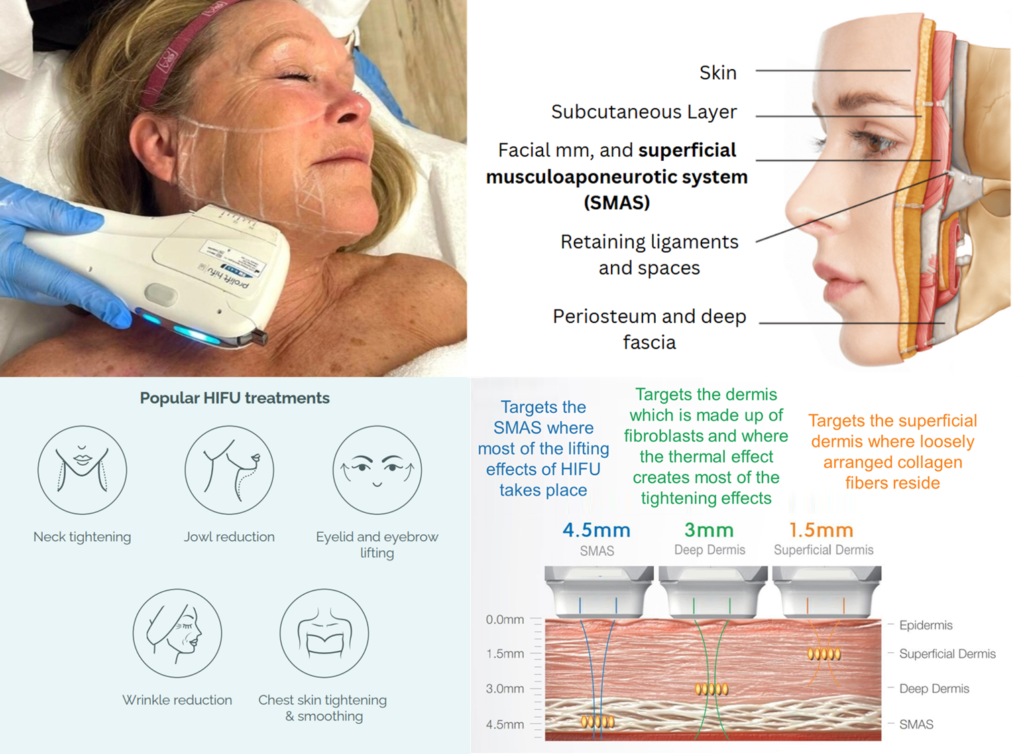
HIFU is a non-invasive, cutting-edge treatment that uses ultrasound energy to target deep layers of skin and tissue, promoting tightening, lifting, and overall skin rejuvenation. It’s particularly popular for skin tightening and lifting in areas that tend to show signs of aging, like the face, neck, and jawline.
Here’s a breakdown of what HIFU is, how it works, the benefits, and what you can expect from a typical treatment:
What is it?
HIFU is a medical-grade technology that uses focused ultrasound waves to deliver targeted energy to the deeper layers of the skin. Unlike lasers or radiofrequency treatments, HIFU uses ultrasound energy to penetrate below the skin’s surface without harming the outer layers, stimulating collagen and elastin production deep in the dermis.
This results in the lifting and tightening of the skin over time, improving the appearance of sagging skin, wrinkles, and fine lines.
How does it work?
HIFU works by using focused ultrasound waves to heat targeted tissues beneath the skin’s surface. The process has two key mechanisms:
-
Thermal Injury: The ultrasound energy creates small, controlled injuries in the deeper layers of the skin (dermis and SMAS layer), which stimulates the body’s natural healing response. This results in increased collagen production, which tightens the skin and improves its elasticity over time.
-
Skin Lifting: As collagen remodeling occurs, the skin gradually becomes firmer, tighter, and more youthful. The energy is specifically focused on the Superficial Muscular Aponeurotic System (SMAS) layer — a deeper layer of tissue that helps with skin lifting and firmness. This is also the layer that is typically targeted by surgical face lift. This makes HIFU an effective treatment for a modest face lift without invasive surgery.
Where can you treat it?
HIFU is primarily used for skin tightening and lifting, particularly for areas with sagging or loss of elasticity. The common areas treated with HIFU include:
-
Face: To tighten sagging skin around the jawline, neck, and cheeks.
-
Neck: To address loose skin and wrinkles on the neck area.
-
Eyebrow Lift: To lift the brows for a more youthful appearance.
-
Chin: To reduce the appearance of a double chin and improve the jawline contour.
-
Décolletage: For tightening and smoothing the skin on the chest area.
Why try HIFU?
- Non-surgical facelift:
- Stimulates collagen production deep within the skin
- Helps lift and tighten the skin, improving sagging or loose skin
- Minimal downtime:
- Can resume normal activities immediately after treatment.
- May experience mild redness and swelling.
- Non-invasive procedure:
- Does not involve needles or incisions
- Lower risk of side effects of complications
- Precision and depth of treatment:
- Uses focused ultrasound waves to target deeper layers of the skin, specifically the SMAS layer.
- Same layer targeted during surgical facelift.
- Effective in tightening and lifting without damaging the surface of the skin.
- Long-lasting results:
- On average can last 6 months to 1 year depending on age, skin condition, desired outcome and lifestyle
- Targets multiple areas:
- Customizable to target specific areas of concern
- Can be used for jaw contouring:
- In addition to tightening and lifting, HIFU can target unwanted fat tissues to provide a more contoured jawline
🌟HIFU vs. RF Microneedling
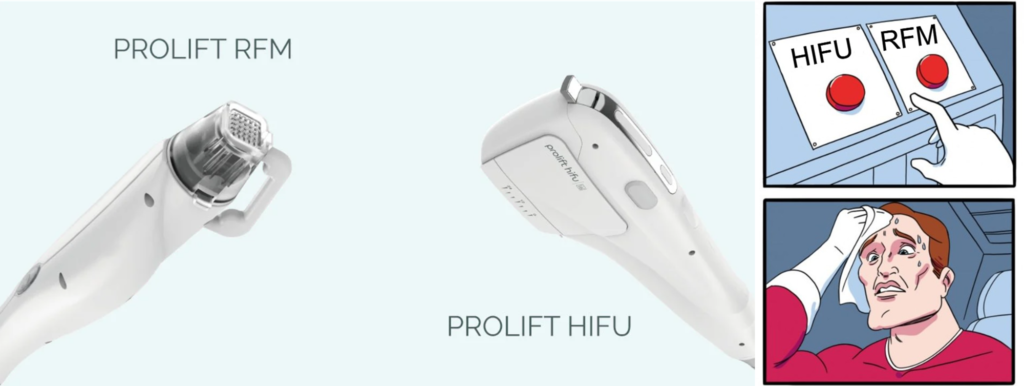
In the world of non-invasive cosmetic treatments, two popular methods have gained significant attention for their ability to tighten skin, reduce wrinkles, and improve overall skin appearance: High-Intensity Focused Ultrasound (HIFU) and Radiofrequency Microneedling (RFM).
While both are effective skin rejuvenation treatments, they differ in their mechanisms of action, targeted areas, and ideal use cases. Understanding the differences between these two can help you make an informed decision about which treatment is right for your specific needs.
|
Aspect |
HIFU |
RFM |
| Technology | Uses focused ultrasound waves to penetrate deep layers of skin. | Uses tiny needles to create micro-injuries and deliver radiofrequency (RF) energy. |
| Primary Goal | Lifts, tightens, and stimulates collagen production. | Improves skin texture, tightens, and reduces wrinkles + scars. |
| Depth | Targets medium to deeper layers of the skin layers (e.g. dermis and SMAS; 1.5, 3, 4.5mm depth) | Targets superficial and deeper layers (0.5-3.5 mm) |
| Procedure | Non-invasive, ultrasound energy delivered through a transducer. | Involves micro-needles puncturing the skin and then delivering RF energy. |
| Recovery | Minimal to no downtime. Mild redness or swelling may occur. | Mild redness or swelling for a few hours to a day. |
| Discomfort Level |
Mild discomfort from ultrasound energy at deeper layers.
1.5/10 pain |
Topical numbing cream applied prior to treatment. Mild discomfort due to needle puncture and RF energy.
3/10 pain |
| Common areas | Face, neck, jawline. | Face, neck, around eyes, areas with acne scars and fine lines. |
| Duration Time | 30-90 mins depending on area treated per session. | 60 mins per session. |
| Ideal for | Lifting and tightening of skin for mid to moderate skin laxity. | Improve texture, scars, and overall skin rejuvenation. |
| # of sessions | 1-2 sessions for visible results (depends on skin condition). | 3-6 sessions recommended for optimal results. |
Combining HIFU and RFM can offer the best of both worlds. While HIFU works at a deeper level to tighten and lift, RFM targets the surface for smoother, more youthful skin. Together they can provide:
- Comprehensive skin rejuvenation
- Improved skin laxity
- Enhanced collagen stimulation
- Superior results
Choosing between HIFU and RFM depends on your unique skin goals. The number of sessions and intervals between sessions may vary depending on individual skin type and concerns. It is important to consult with a trained and licensed professional to determine which treatment is suitable for your specific skin concerns.
⚡ Light Up Your Skin: How IPL Rejuvenates
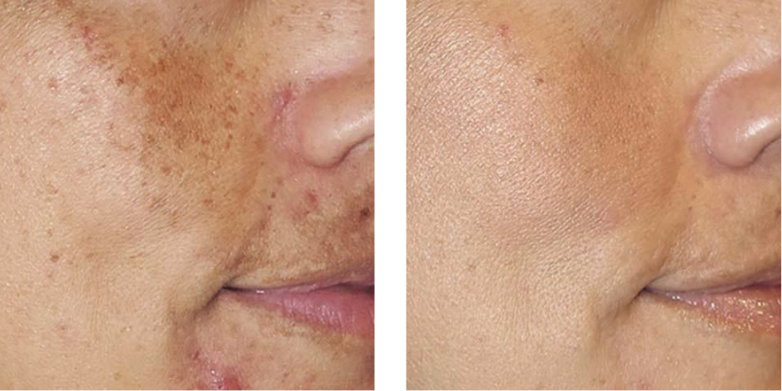
Intense Pulsed Light (IPL) is a non-invasive cosmetic and dermatological treatment that uses high-intensity, broad-spectrum light to improve the appearance of the skin. It is often used to address a variety of skin concerns and is a popular choice for skin rejuvenation. Here’s how IPL works and what it’s used for:
How IPL Works: IPL devices emit short bursts of high-intensity light that target specific chromophores in the skin, such as melanin (responsible for pigmentation) and hemoglobin (responsible for redness). The light energy is absorbed by these chromophores, which then heat up and are subsequently destroyed or broken down. This process stimulates the body’s natural healing response, leading to improvements in the targeted skin issues.
Common Uses of IPL:
-
Sun Damage and Pigmentation: IPL is often used to reduce the appearance of sunspots, age spots, freckles, and uneven pigmentation caused by sun exposure.
-
Vascular Issues: IPL can help treat visible blood vessels, broken capillaries, and redness associated with conditions like rosacea.
-
Hair Removal: IPL is an effective method for hair removal. It works by targeting and damaging the hair follicles to inhibit future hair growth.
-
Skin Rejuvenation: IPL can improve skin texture, reduce fine lines and wrinkles, and stimulate collagen production, leading to a more youthful appearance.
-
Acne Treatment: IPL can help reduce inflammation and kill the bacteria associated with acne. It can also minimize the appearance of acne scars.
-
Freckle and Birthmark Removal: For certain types of freckles and birthmarks, IPL can help lighten or remove them.
-
Minimizing Pore Size: IPL treatments can lead to a reduction in the appearance of enlarged pores.
Benefits of IPL:
-
Non-invasive and requires little to no downtime.
-
Effective for a wide range of skin issues.
-
Can be used on the face, neck, chest, hands, and other areas of the body.
-
Typically well-tolerated with minimal discomfort.
IPL is generally performed in a series of sessions to achieve the desired results. The specific number of sessions and the intervals between them depend on the individual’s skin type, concerns, and the IPL device used. It’s important to consult with a licensed practitioner to determine if IPL is a suitable treatment for your specific skin needs.
IPL is safe and effective when performed on the right candidates. However, it should not be performed on recently tanned skin, as this increases the risk of undesired side effects.
🎯Targeting the Double Chin and Other Unwanted Localized Fat
Belkyra is an FDA-approved injectable treatment designed to reduce small pockets of fat—most commonly under the chin (“double chin”). It uses deoxycholic acid, a naturally occurring substance that breaks down fat cells. Once destroyed, these cells can no longer store or accumulate fat.
Belkyra is ideal for spot treatment of fat in small, defined areas and is not intended for overall weight loss or skin tightening. Most suitable candidates are within 10% of their target body weight and have mild to moderate localized fat.
Important: Belkyra does not tighten loose skin or remove excess skin.
Who Is a Candidate?
Those with mild to moderate submental fat (see scale below) are best suited. Patients with severe fullness or significant skin laxity may require alternative options.
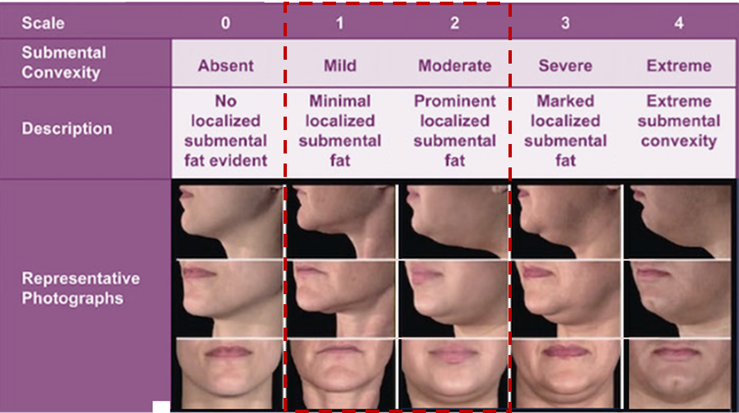
What to Expect – Downtime
Swelling, tenderness, and redness are normal and can last up to 2–3 weeks, with most swelling subsiding by day 7. Bruising is common and usually resolves in 5–7 days. Avoid intense physical activity during this period to reduce swelling and discomfort.
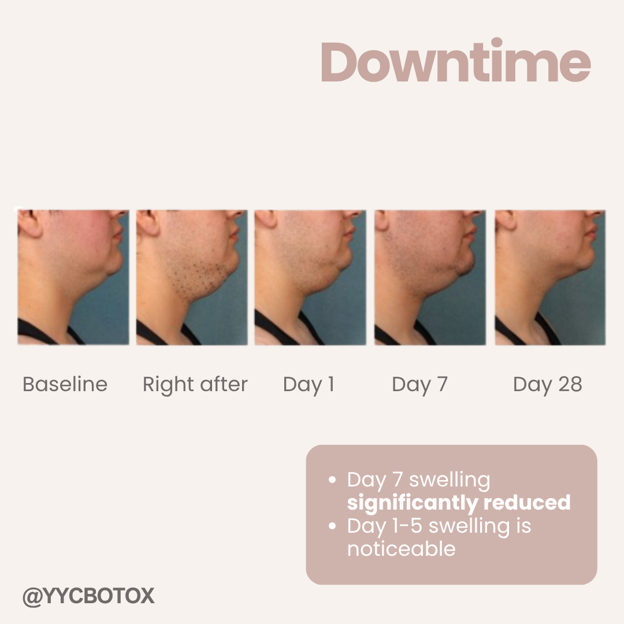
☀️Summer-Safe Skin Treatments: What You Can (and Should) Do for Radiant Skin
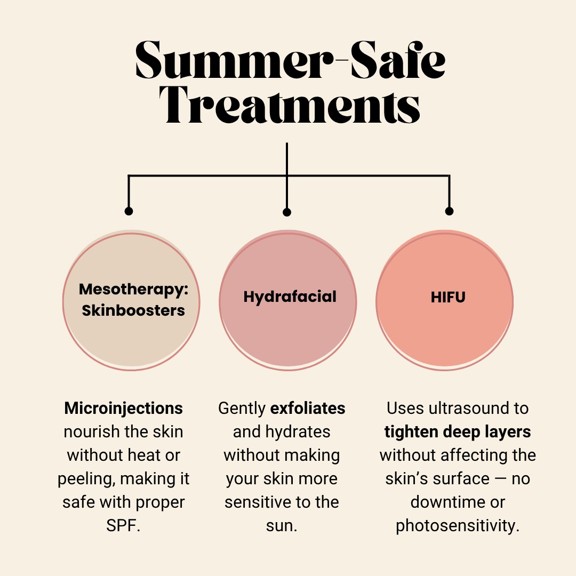
When the temperatures rise, it’s time to adjust more than just your wardrobe. Your skincare needs change in the summer too, and while some treatments are better saved for cooler months, others are perfectly safe under the summer sun (with proper aftercare, of course!)
If you’re wondering what’s safe, effective, and glow-inducing during summer, here’s your expert guide to in-clinic skin treatments that won’t disrupt (too much) of your sunny plans. We’ll provide you with our TOP 3 and others that make the cut 😉
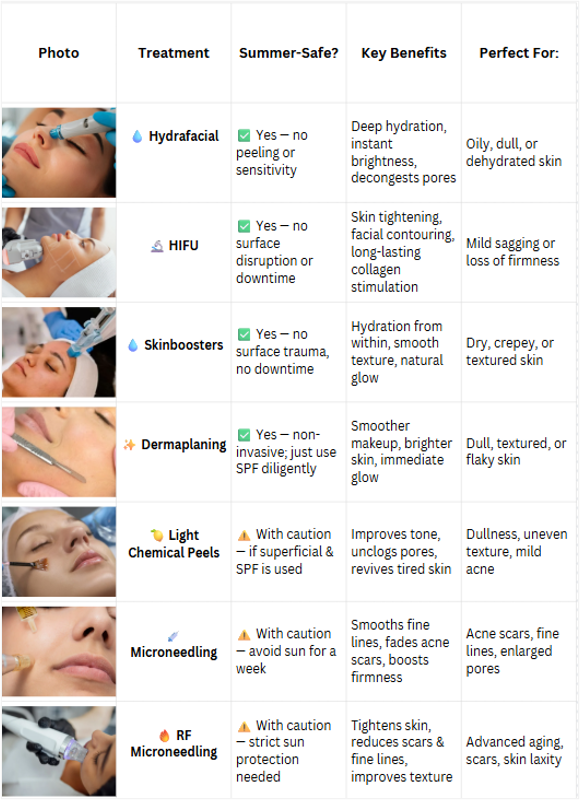
☀️ Tips for Safe Summer Treatments
- Apply SPF religiously: Every single day – no exceptions.
- Time it right: Avoid scheduling deeper treatments right before a holiday or prolonged sun exposure.
- Hydrate inside and out: Drink plenty of water and use hydrating products post-treatment.
- Stick to professional advice: Your skin therapist can tailor the best summer treatment plan for you.
💧Smooth, Radiant Skin with NCTF & Mesotox – Here’s How
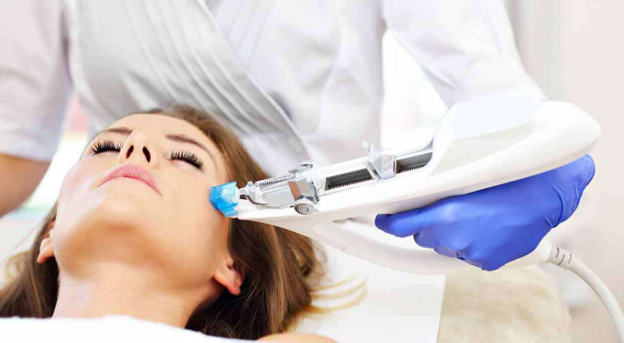
Mesotherapy is quickly gaining popularity for its ability to rejuvenate skin and address multiple beauty concerns. Whether you’re looking to reduce fine lines, improve skin texture, or tackle stubborn fat, mesotherapy offers a versatile and non-invasive solution. But what exactly is mesotherapy, and how does it work? Let’s dive into this transformative treatment and explore your next possible treatment option.
What is Mesotherapy?
Mesotherapy is a non-surgical cosmetic procedure that involves the injection of a cocktail of active ingredients—such as vitamins, minerals, amino acids, antioxidants, and hyaluronic acid into the mesoderm. This layer is responsible for providing skin with its structure, elasticity, and nourishment. By targeting the mesoderm directly, mesotherapy stimulates collagen production, enhances hydration, and promotes overall skin rejuvenation.
How does Mesotherapy work?
- A series of microinjections are administered into the skin simultaneously using a 9-pin needle cartridge.
- The specific blend of products used will vary depending on your treatment goals (ex. Skinboosters, PDRN, NCTF, Mesotox).
- Once injected, the ingredients begin to work beneath the surface, stimulating the skin’s natural healing process. The active ingredients will hydrate the skin, boost collagen production, and increase circulation resulting in smoother, firmer, and more youthful skin over time.
Beyond Glow and Pores: Benefits to Your Skin
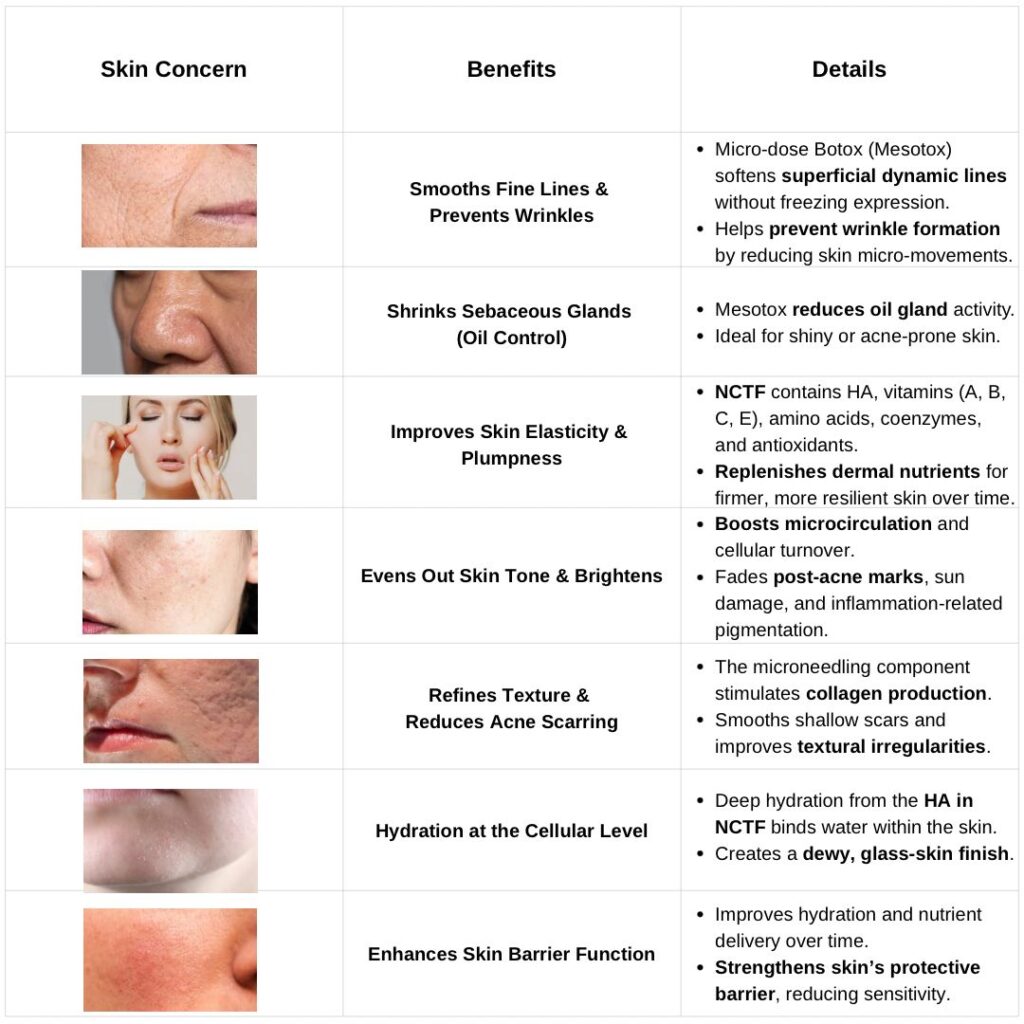
Why Our Clients Love It:
✅Non-surgical / minimal downtime
✅Customizable to your skin goals
✅Natural-looking results
✅Works together to enhance your botox and filler treatments
🩸PRF Gel: A Natural Way to Restore and Rejuvenate
 If you’re looking for a regenerative, natural approach to facial rejuvenation, PRF (Platelet-Rich Fibrin) Gel is a powerful alternative to traditional dermal fillers. It’s made entirely from your own blood and is rich in platelets, fibrin, and growth factors that stimulate collagen and encourage long-term tissue regeneration.
If you’re looking for a regenerative, natural approach to facial rejuvenation, PRF (Platelet-Rich Fibrin) Gel is a powerful alternative to traditional dermal fillers. It’s made entirely from your own blood and is rich in platelets, fibrin, and growth factors that stimulate collagen and encourage long-term tissue regeneration.
How PRF Gel Works
The process starts with a simple blood draw. We then spin it in a centrifuge to separate the PRP, and then process it into a gel-like consistency. This gel is injected into areas like the under-eyes, cheeks, or smile lines, where it provides soft, natural volume and gradual improvements in skin texture. Unlike fillers that fade out quickly, PRF continues working beneath the surface by boosting your collagen production over time.
Benefits of PRF Gel
-
Natural and Biocompatible: Since it’s made from your own blood, PRF carries minimal risk of allergic reaction or rejection.
-
Long-Lasting Results: Improvements in skin tone and texture can last up to a year.
-
Versatile Uses: Great for under-eye hollows, fine lines, and areas of subtle volume loss.
PRF vs PRP: What’s the Difference?
You’ve probably heard of PRP (Platelet-Rich Plasma), which delivers a quick burst of growth factors. PRF, on the other hand, releases them slowly over time—more like a steady drip of healing and regeneration. This extended release continues to stimulate collagen for weeks after treatment, so results build gradually and last longer. It’s not just a quick fix; it’s a long-term investment in your skin.
Is PRF Gel Right for You?
If you’re looking for a natural, gradual approach to skin rejuvenation—without the puffiness or stiffness that sometimes comes with fillers—PRF Gel may be a perfect fit. Book a consultation and let’s talk about what’s right for your skin.
💉How Much Botox Will $500 Get Me?
Botox is a popular treatment for smoothing wrinkles, preventing fine lines, and even treating medical conditions like migraines and TMJ. If you’re considering Botox and have a budget of $500, you might be wondering how much treatment you can get for that price. Here’s a breakdown to help you understand what to expect.
Understanding Botox Pricing
Botox is typically priced per unit, with costs ranging between $8 to $15 per unit depending on the clinic and location. Some providers may also offer Botox by the treatment area, but per-unit pricing is the most common.
How Many Units Can You Get for $500?
With Botox costing around $8 to $10 per unit on average, a $500 budget would get you approximately 50 to 60 units of Botox. However, this number can vary based on the clinic’s pricing structure.
How Many Units Do You Need?
Here’s a general guideline for the typical number of Botox units needed per area:
- Forehead lines: 10–20 units
- Glabellar lines (frown lines between the brows): 15–25 units
- Crow’s feet (around the eyes): 6–12 units per side
- Bunny lines (nose wrinkles): 4–6 units
- Masseter (jawline slimming, TMJ treatment): 25–50 units per side
With $500, you could treat one or two smaller areas (like forehead lines or crow’s feet) or get a partial treatment in a larger area (like the masseter muscles for TMJ).
Maximizing Your Botox Budget
- Prioritize key areas: If you’re on a budget, focus on the areas that will have the biggest impact.
- Consult with a professional: A Botox provider can assess your needs and recommend the best way to allocate your units.
Final Thoughts
For $500, you can get a meaningful amount of Botox to refresh your look or address a medical concern. The exact amount you need depends on your treatment goals, so scheduling a consultation with an experienced injector is the best way to ensure you get the best results for your budget.
Want to see exactly how much Botox you need? Try our Botox Calculator to estimate your treatment cost.
Interested in Botox? Contact our clinic today to book your consultation and find out how to make the most of your treatment!
🎁Treat yourself (or loved ones) this holiday season!
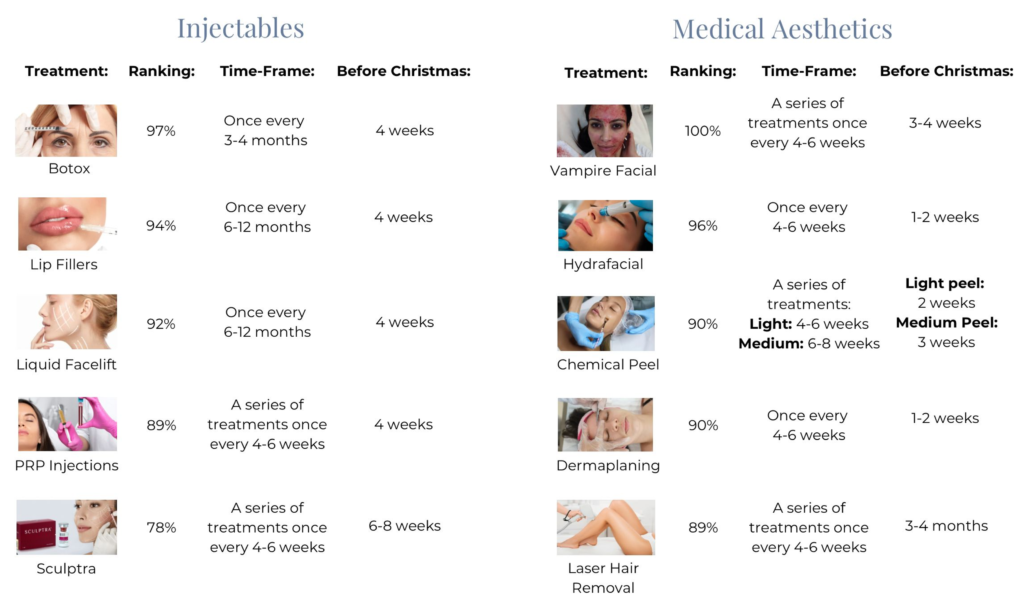
Did you know that there is a website that clients use to rank their favorite aesthetic treatments? Yes, these are real people with real, honest experiences and feedback!
www.RealSelf.com ranks invasive and non-invasive medical aesthetic treatments based on its worth-it-ness, or in other words, the value of client investment to their skin.
The holiday season is a time for joy, celebration, and making memories with family and friends. It’s also a great opportunity to treat yourself—or a loved one—to a little extra pampering. With the season of giving around the corner, how about the gift of glowing, radiant skin? Whether you’re looking to rejuvenate your complexion, smooth out wrinkles, or restore youthful volume, there are a variety of skincare treatments that can help you or someone you love feel refreshed and ready to shine this holiday season.
Here’s a guide to the most popular skin treatments to consider before the holidays, and when to book them for optimal results.
Not sure which treatment to get for yourself (or loved ones)? We have the most popular injectable and non-invasive/minimally invasive treatments listed on the left.
💡Superficial Musculo Aponeurotic System (SMAS)

The SMAS layer is a fibrous structure in the face and neck that plays a crucial role in facial anatomy. It is often described as an organized fibrous network composed of the platysma muscle, parotid fascia, and fibromuscular layer covering the cheek. It consists of a network of connective tissue that connects the muscles of facial expressions to the skin and underlying structures. The SMAS layer helps support facial contours and allows for movement, contributing to expressions and overall facial dynamics.
The SMAS layer is important for anti-aging and overall appearance for several reasons:
-
Structural Support:
-
-
It provides structural integrity to the face, helping to maintain its shape and volume.
-
As we age, this layer can lose elasticity and strength, contributing to sagging skin and a less youthful appearance.
-
-
Facial Contours:
-
-
It connects the muscles of facial expressions to the skin, influencing how facial contour appears.
-
Tightening or repositioning this layer during cosmetic procedures can enhance the natural contours of the face.
-
-
Dynamic Movement:
-
-
It plays a role in facial expressions.
-
Maintaining its function helps ensure that facial movements remain natural and expressive, which is important for communication and overall appearance.
-
-
Long-Lasting Results:
-
-
When addressed in surgical procedures like facelifts, the SMAS can lead to more durable results compared to just tightening the skin.
-
This is because it addresses the underlying structures that contribute to sagging.
-
-
Minimized Skin Laxity:
-
-
By targeting the SMAS, practitioners can better counteract the effects of gravity and aging, reducing skin laxity and improving the overall youthful appearance of the face.
-
Here are some treatments that specifically target the SMAS layer:
-
Surgical Facelifts: Traditional facelift surgery involves lifting and tightening the SMAS layer to achieve more significant and lasting results.
-
Radiofrequency Treatments: Devices such as Endymed deliver radiofrequency energy to the deeper layers of the skin, including the SMAS, promoting collagen remodeling and tightening.
-
High-Intensity Focused Ultrasound (HIFU): HIFU uses concentrated ultrasound energy to heat the SMAS layer to stimulate collagen production in the SMAS layer, promoting tightening and lifting without surgery.
-
Collagen Stimulating Injectables: While not directly targeting the SMAS, certain collagen stimulating injectables like Sculptra or Radiesse can provide volume and structural support to areas around the SMAS, indirectly enhancing its effect.
-
Neuromodulator (e.g. Botox) Injections: Tightening the mimetic facial muscles and directly alters the conformational shape of the overlying SMAS.
-
Thread Lifts: This minimally invasive procedure involves inserting dissolvable threads that can lift and support the SMAS layer, providing a subtle lift to the face.
🛑Bad Skin Habits You Need to Break!
It is no secret that we all want our skin to look and feel its absolute best, but there is a lot of misinformation about skincare products and treatments online that it can be difficult and confusing to determine what you should and shouldn’t be doing when caring for your skin.
Even if you are someone who has a thorough skincare regimen, there are certain habits that will negatively impact the health and appearance of your skin. Here’s how you can improve your skincare routine and change lifestyle habits to ensure you keep your skin looking fabulous!
Here’s a list of bad skin habits to break:
-
Skipping SPF☀️: Not using sunscreen can lead to premature aging, dark spots, and an increased risk of skin cancer. Daily SPF protects against UV damage.
-
Pore strips👃🏼: Although it is seen as a “quick fix,” it does more harm than good. Pore strips aggressively rip out blackheads from the skin, which can damage the skin and widen pores.
-
Sleeping in makeup💄: This can disrupt your skin’s natural renewal process, leading to dullness and premature aging. Leftover makeup will clog pores, contributing to skin irritation and breakouts.
-
Picking at your skin🤏: This can introduce bacteria and lead to scarring or increased inflammation. Avoid touching your face and use targeted/spot treatments.
-
Over exfoliating🧼: While exfoliation helps remove dead skin cells, too much can strip the skin’s natural barrier, leading to irritation and dryness.
-
Being inconsistent & expecting results🫠: Your skin takes time to regenerate and build efficacy. Being inconsistent can be frustrating and counterproductive.
-
Neglecting the neck, chest, & hands🤲: These areas show signs of aging, such as wrinkles and sagging, just like the face. They have thinner skin and can age faster if not cared for.
-
Not drinking enough water💦: Dehydrated skin can look dull and aged. Drink plenty of water and use topical serums and moisturizers suited for your skin type.
-
Using makeup wipes❌: This will strip your skin from its natural oils, causing dehydration and skin irritation due to harsh chemicals and preservatives. Instead, double cleanse using an oil cleanser followed by a gentle cleanser.
-
Ignoring Skin Type🙈: Using products that aren’t suited for your skin type (like heavy creams on oily skin) can exacerbate issues. Chat with a skincare specialist if you’re unsure of your skin type.
-
Lack of Sleep😴: Poor sleep can lead to a dull complexion and dark circles. Aim for quality rest to allow your skin to repair.
By ditching these habits, you’ll promote healthier, more vibrant skin!
💉Masseter Botox for TMJ: What You Need to Know

Temporomandibular Joint (TMJ) Dysfunction may sound like a very complex medical condition, but it is something that impacts a significant amount of the population at some point in their lives. It can be a very painful and frustrating condition, and cause discomfort in your day-to-day life.
What is TMJ?
TMJ is the hinge that connects your jawbone to your skull. There’s a pair of these joints on each side of your head. They are crucial for activities such as talking, chewing, and yawning. TMJ disorder, or TMD, refers to a range of problems that affect this joint and the surrounding muscles.
Causes of TMJ
TMJ disorder can arise from a variety of factors, often in combination. Common causes include:
-
Jaw Injury: Trauma to the jaw or head can disrupt the normal function of the TMJ.
-
Teeth Grinding and Jaw Clenching: Often related to stress or anxiety, these habits can put extra pressure on the TMJ.
-
Arthritis: Osteoarthritis or rheumatoid arthritis can affect the TMJ just like any other joint in the body.
-
Misalignment of the Jaw: Problems with how the teeth and jaw align can lead to TMJ issues.
-
Genetic Factors: Some individuals may be more predisposed to TMJ disorders due to their genetics.
Symptoms of TMJ
TMJ disorder can manifest in various ways, and symptoms can range from mild to severe. Some common signs include:
-
Jaw Pain: Discomfort or pain in the jaw joint or surrounding muscles.
-
Headaches: Frequent headaches or migraines that seem to originate from the jaw area.
-
Earaches: Pain or discomfort in the ear, even though there may not be an ear infection.
-
Facial Pain: Pain or tenderness in the face, especially around the jaw and cheeks.
-
Clicking or Popping Sounds: Auditory symptoms when you open or close your mouth.
-
Limited Jaw Movement: Difficulty or pain when trying to open your mouth wide.
What is the Masseter Muscle?
The masseter muscle is one of the major muscles responsible for the movement of the jaw. It’s a thick, quadrilateral muscle that forms part of the masticatory (chewing) muscles. It is located in the region of the jaw and plays a vital role in the process of chewing food.
How Does Masseter Botox Help with TMJ?
1. Reduces Muscle Activity
In cases of TMD, the masseter muscles can become overactive due to factors like teeth grinding or jaw clenching. This overactivity can lead to pain, discomfort, and jaw dysfunction. Botox works by relaxing these muscles, which helps to reduce the strain on the TMJ.
2. Alleviates Pain
By reducing muscle activity, botox can also help alleviate the associated pain. Many individuals with TMD experience significant jaw pain, headaches, or earaches, which can be mitigated by relaxing the masseter muscles.
3. Decreases Teeth Grinding and Clenching
For those individuals who grind or clench their teeth, often as a response to stress or misalignment, botox can also help. By weakening the masseter muscles, botox reduces the force and frequency of these actions, leading to less strain on the TMJ.
How many units of botox will you need for masseters?
-
Since the masseter muscle is a strong muscle and has a large surface area, it will require a greater amount of units in comparison to areas such as your forehead, especially because the masseter muscles are being used regularly for chewing.
-
It may vary depending on the severity of your TMJ Disorder.
-
Biological gender is usually a factor as females generally have smaller masseter muscles than males.
-
When used for cosmetic purposes, such as face slimming, the baseline muscle mass and desired outcome will dictate the dosage
How long does it take to see results?
-
Since it is a larger muscle it takes a little longer to take full effect compared to the upper face
-
You will see results within 14 days and full effects within 4-6 weeks post-procedure.
How long does it typically last?
-
The longevity varies from person-to-person and other factors that are involved.
-
Typically, it can last anywhere between 4-6 months.
-
Varies with the severity of your TMJ Disorder.
-
You may metabolize the product faster if you are an active individual.
-
Can vary with work or activities that require regular active mouth movements
-
Repeated treatments are necessary to maintain results.
😁Isabelle’s Journey with Masseter Botox
Why I get masseter botox:
I never really paid attention to how much I clench my jaw and teeth until a few years ago. A part of it may be because I had a bad experience with my dentist, which caused excruciating pain on my back tooth. Clenching my jaw would sometimes relieve the pain, which is probably what triggered me to clench my jaw without thinking about it. Plus stress and anxiety, of course.
My jaw clenching and teeth grinding only worsened over time. My partner would wake up in the middle of the night because he can hear me grinding my teeth in my sleep. My back tooth began to wear down and became thin to the point where I actually had to extract the tooth at the very back.
After discovering that botox can help relieve the tension, I was super excited even though it is temporary. I wouldn’t say my symptoms are very severe but I know that it negatively impacts my life. A bonus is that it slims down my face. 😉
How often do I get masseter botox?
I live quite an active lifestyle, including running/training for races and weight lifting as well, leading to my botox wearing off a little faster. Around the 4 month period, I begin to notice that I am clenching my jaw more often, which is my sign to get another treatment.
Although the masseters are a larger muscle and botox takes a little bit longer to fully kick in compared to the upper face, I feel a release in tension just after 24 hours.
🪙Cost of Fillers in Calgary
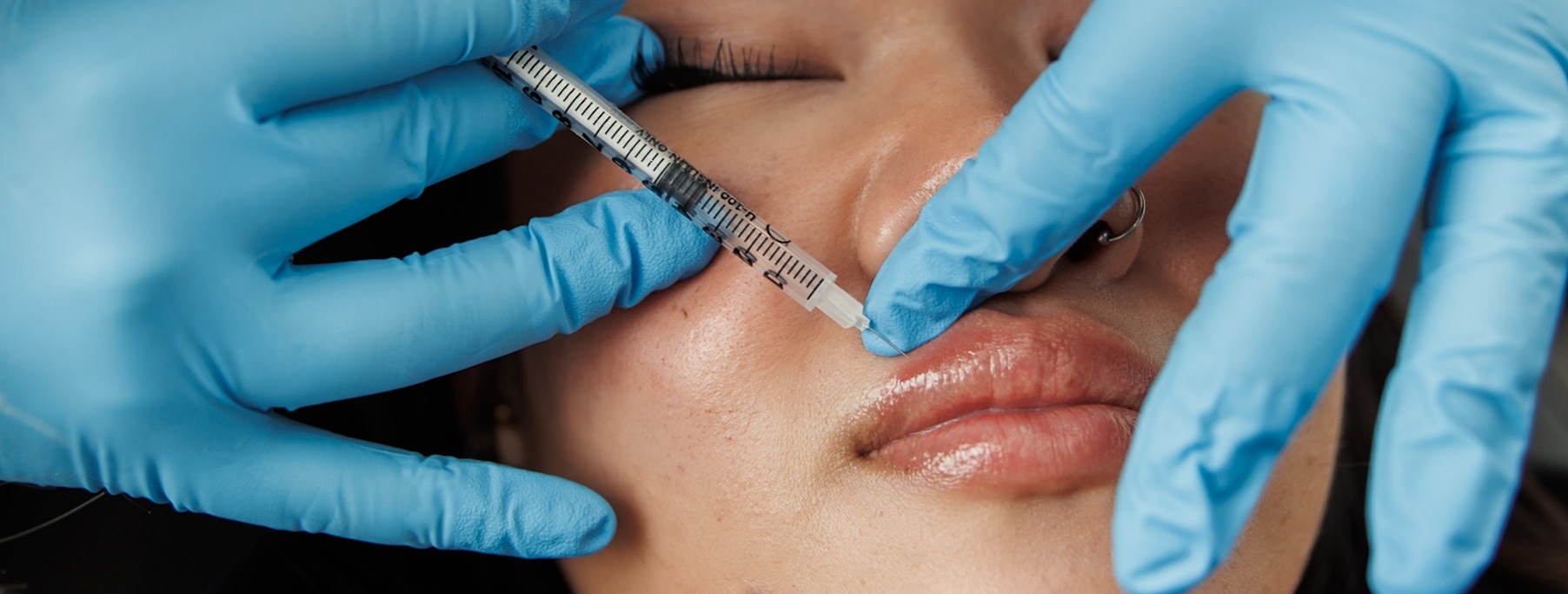
Fillers are a popular cosmetic treatment used to enhance facial features and reduce the appearance of wrinkles and fine lines. They are a non-surgical option that involves injecting a gel-like substance into the skin to add volume and contour to the face. In Calgary, the cost of fillers can vary depending on several factors, such as the type of filler, the amount required, and the experience of the injector.
On average, the cost of hyaluronic acid fillers in Calgary ranges from $600 to $1,000 per syringe. However, the actual cost can vary based on the type of filler used. Each type of filler has its own unique properties and benefits, and the cost can vary based on the specific brand and product used. For example, fillers used to fill the jawline consist of a different material than those used to line the tear troughs.
-
The amount of filler required can also impact the cost of treatment. The amount of filler required can vary depending on the area being treated, the severity of the volume loss and the desired results. For instance, treating the nasolabial folds (smile lines) may require a full syringe of filler, while treating the cheeks may require two syringes. It’s important to note that the amount of filler required may differ from person to person based on individual needs and expectations.
-
The experience of the injector can also play a role in the cost of fillers in Calgary. Experienced injectors who have a reputation for providing high-quality results may charge more for their services than newer injectors who are still building their clientele. It’s important to choose a reputable and experienced provider who uses high-quality products to ensure the best possible results.
-
Location of the clinic plays a role in the cost of your treatment. Whereas one dermatology clinic located in a brand-new plaza may charge more per treatment, a smaller clinic with less staff and rent to pay will affect the price of your filler treatment.
- Clinic ownership & business model can also influence pricing. Some clinics owned by large corporations or private equity firms may prioritize shareholder profits over patient care, potentially leading to higher costs without necessarily improving quality. It’s always beneficial to research the clinic’s reputation and patient reviews before making a decision.
While cost is an important factor, it shouldn’t be the only consideration when choosing a provider. The experience and qualifications of the injector, as well as the quality of the products used, play a crucial role in achieving safe and natural-looking results. Always opt for a provider with a strong reputation and a commitment to patient safety and satisfaction.
At YYC Botox, we are proud to use high-quality fillers injected by our experienced professionals. We’re also proudly independently owned and operated, ensuring our focus remains on patient care and exceptional results.
💸Cost of Botox in Calgary
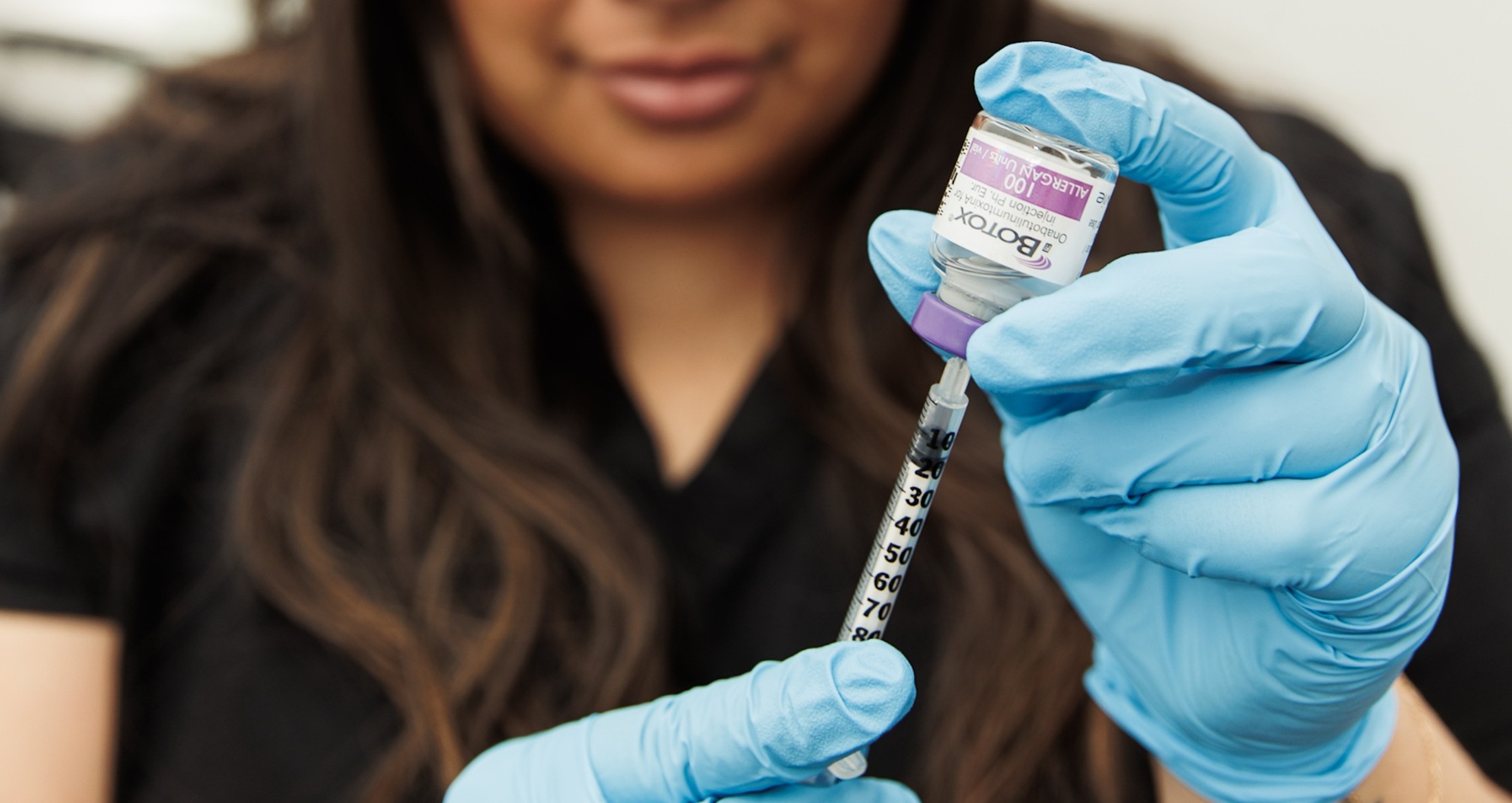
Botox is a popular cosmetic procedure used to reduce wrinkles and fine lines. It is an injectable treatment that uses a purified form of the botulinum toxin to temporarily paralyze muscles, resulting in a smoother and more youthful appearance. Botox has gained immense popularity in recent years, with more and more people opting for the treatment to achieve a more youthful and rejuvenated look. About 1 in 4 women in Canada are either receiving or thinking about recieving Botox injections. However, one important factor to consider before getting Botox is the cost.
In Calgary, the cost of Botox treatment can vary depending on several factors, such as the number of units required, the location of the clinic, and the experience of the injector. On average, the cost of Botox treatment in Calgary ranges from $8 to $15 per unit. However, the actual cost can vary based on the factors mentioned above.
-
The number of units required for Botox treatment can vary depending on the area being treated and the severity of the wrinkles. For instance, treating the frown lines between the eyebrows may require anywhere from 20 to 30 units, while treating the crow’s feet around the eyes may require 12 to 20 units. It’s important to note that the number of units required may differ from person to person based on individual needs and expectations.
-
The location of the clinic can also play a role in the cost of Botox treatment. Typically, clinics located in upscale neighborhoods or commercial areas may charge more for their services than those located in less affluent areas. This is due to the higher rent and operating costs associated with such locations.
-
The experience of the injector can also impact the cost of Botox treatment in Calgary. Experienced injectors who have a reputation for providing high-quality results may charge more for their services than newer injectors who are still building their clientele. Nurse injectors vs physician injectors will differ in price point.
- The ownership and business model of a clinic can also influence pricing. Some clinics owned by large corporations or private equity firms may prioritize shareholder profits over patient care, potentially leading to higher costs without necessarily improving quality. It’s always beneficial to research the clinic’s reputation and patient reviews before making a decision.
It’s important to note that the cost of Botox treatment is not the only factor to consider when choosing a provider. The experience and qualifications of the injector, as well as the quality of the products used, are also important factors to consider. It’s always recommended to choose a reputable and experienced provider who uses high-quality products to ensure the best possible results.
At YYC Botox, we are proud to use high-quality fillers injected by our experienced professionals. We’re also proudly independently owned and operated, ensuring our focus remains on patient care and exceptional results.
🤔Is Botox Covered by Insurance?
Botox is a widely popular treatment used for both cosmetic and medical purposes. Many Albertans wonder whether insurance or public health plans cover the cost of Botox treatments. The answer depends on the reason for the treatment.
Cosmetic Botox
If you’re looking to get Botox for cosmetic reasons—such as reducing wrinkles, fine lines, or enhancing facial aesthetics— most private insurance plans and public health plans do not cover the cost. Cosmetic procedures are considered elective and are typically paid out of pocket.
Medical Botox
Botox is sometimes used to treat select medical conditions in certain situations, including chronic migraines, excessive sweating (hyperhidrosis), muscle spasms, and certain neurological disorders. In some cases, public health plans or private insurance plans may cover Botox injections when they are deemed medically necessary and prescribed by a physician. The criteria to meet to obtain coverage is typically strict and required paperwork varies by plan provider. Additional documentation is typically required by an independent health care professional.
Some private insurance plans offer Health Care Spending Accounts (HCSA) or Wellness Accounts, which can be used to cover the cost of medical Botox treatments for conditions like migraines, hyperhidrosis (excessive sweating), and TMJ disorders. If Botox is not covered under your standard health plan, you may be able to submit receipts for reimbursement through these accounts. Check with your insurance provider to confirm eligibility and required documentation.
How to Determine Coverage
If you’re considering Botox for medical reasons, it is essential to speak to your insurance providers. They will typically require additional documentation, such as medical history, specialist referrals, or proof of unsuccessful alternative treatments and require paperwork to be completed by your family physician.
As a cosmetic provider, we are conflicted and cannot complete paperwork to help you get medical Botox coverage. Your primary physician or a specialist must be the one to assess your condition and submit the required forms.
Botox insurance, medical Botox coverage, Botox AHCIP, Alberta Health Botox, insurance for Botox, Botox reimbursement, health care spending account, wellness account, HCSA, medical Botox claim, Botox for migraines coverage, hyperhidrosis Botox insurance, TMJ Botox coverage, private insurance Botox, Botox health benefits, AHCIP Botox coverage, insurance claims Botox, covered Botox treatments, Botox expense claim, Botox for medical conditions, Botox approval process
💉Isabelle's 90 Days Botox Journey

Have you ever thought about getting botox but are unsure of the treatment process or think that you are too young to start? My name is Isabelle, the medical aesthetician at YYC Botox, and I am happy to share my personal experience with you as someone getting botox in her late-20’s for the first time and hopefully help you answer some burning questions.
First, let’s discuss the following:
- What is botox and why botox?💉:
-
-
Botox/Dysport are neuromodulators that relax the muscles. It works by temporarily blocking nerve signals to the treated muscle tissues. It prevents muscles from contracting, reducing the appearance of fine lines and wrinkles.
-
It also provided me with a brow lift which I loved!
-
-
Is it okay to get botox when you’re younger?👧🏻 :
-
Absolutely! Preventative botox is a thing. I’m in my late 20’s but I wish I started in my mid-20’s.
-
Starting earlier before any wrinkles and fine lines are visible on the face will prevent permanent static wrinkles from forming in the future.
-
What is the preparation?📋:
-
My skin was thoroughly cleansed to remove any dirt, makeup and oil from my skin.
-
Dr. Xu assessed my forehead lines (dynamic and static) and marked the areas of injection.
-
-
What are Dynamic and Static lines?
-
Dynamic: lines are visible with facial expressions (laughing, smiling, squinting, etc.).
-
Static: lines and wrinkles are present regardless of expressions. Proactive skincare and preventative botox can help mitigate these lines before they become permanent and harder to treat
-
- Experience and pain🤕 :
- Dr. Xu was comforting throughout the treatment, and ensured that I was not in too much pain.
-
The needle used to inject is an ultra thin needle.
-
The pain was minimal and felt like mosquito bites. As someone with high pain tolerance, I would rate it a 2/10.
-
If you are female, keep in mind that the pain may vary with your monthly cycle.
-
Downtime⌛:
-
Immediately afterwards, I had minor bumps and redness on my forehead that looked like mosquito bites. They went down within an hour.
-
-
Post Care Instructions🚨:
-
Do not touch your face, apply SPF 45+, avoid tanning/sun exposure.
-
No laying down for 4 hours post treatment.
-
Do not apply makeup, avoid strenuous exercising, excessive sweating, and heat / steam (saunas and hot tubs) for 24 hours post treatment.
-
Avoid using retinol/peels/acids after.
-
Botox Lifecycle: My 90 Day Journey 📅:
-
I could see the changes over the following week and the brow lift kicked in around day 7
-
There are a variety of factors to consider when discussing the longevity of botox.
-
On average, it lasts approximately around 3 months for the upper face with the appropriate dose, but this can vary from person-to-person.
-
Each individual is different and may metabolize the product differently. Both your body, your lifestyle and your environment can impact your botox longevity.
FAQs I received about my botox experience❔:
-
“Can you make facial expressions?” – Yes, my goal was not to completely freeze my forehead and allow some natural movement. There’s nothing wrong with wanting areas completely frozen, though!
-
“You’re so young, why do you need botox?” – I was told to get botox before when I got PMU on my eyebrows because they were uneven, but I didn’t know much about it when I was younger. Even PMU cannot even out my brows! Although a brow lift with botox is temporary, I personally believe it makes such a difference overall.


